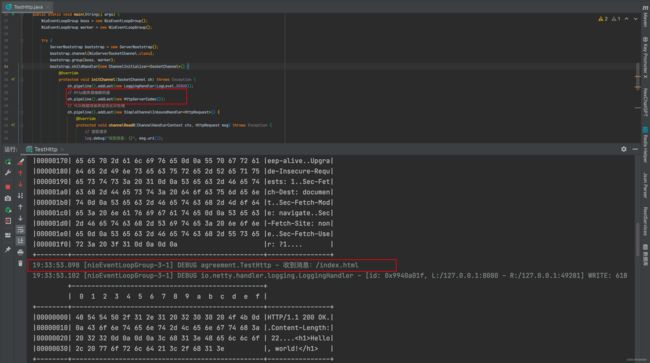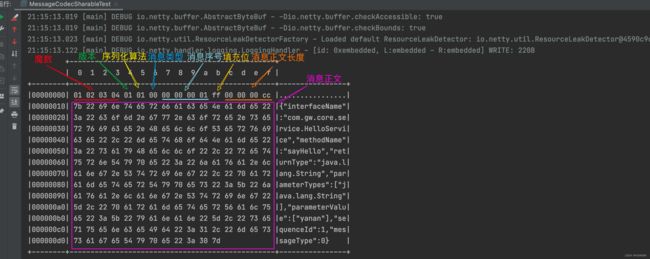使用Netty进行协议开发:多协议支持与自定义协议的实现
使用Netty构建网络应用:多协议支持与自定义协议的实现
- 为什么需要协议❓❓❓
- Netty支持丰富的协议,让程序员专注于业务
- 自定义协议
-
- 1、前置准备
- 2、编解码器抽象类介绍
- 3、编解码器实现
为什么需要协议❓❓❓
在TCP/IP中,数据传输是通过流的方式进行的,这意味着数据被分割成一系列的数据包,并通过网络传输。这样的流式传输方式虽然高效,但没有明确的消息边界,因此在接收端需要一种机制来确定消息的开始和结束位置。协议的目的就是划定消息的边界,制定通信双方要共同遵守的通信规则。
协议的作用就是定义通信双方之间的规则和约定,包括消息的格式、传输方式、错误处理等。通过协议,发送方可以将数据按照一定的格式打包成消息,并在消息中包含必要的元数据,如消息长度等信息。接收方则按照协议规定的格式和规则解析消息,从而正确地还原出发送方发送的数据。
协议还可以定义数据的校验机制,以确保数据的完整性和可靠性。例如,在TCP协议中,每个数据包都有一个校验和字段,接收方可以通过校验和验证数据是否在传输过程中损坏或篡改。如果数据包损坏,接收方可以要求发送方重新发送。
下雨天留客天留我不留,是中文一句著名的无标点符号句子,在没有标点符号情况下,这句话有数种拆解方式,而意思却是完全不同,所以常被用作讲述标点符号的重要性。
- 一种解读,“下雨天留客,天留,我不留”
- 另一种解读,下雨天,留客天,留我不?留
如何设计协议呢?其实就是给网络传输的信息加上“标点符号”。但通过分隔符来断句不是很好,因为分隔符本身如果用于传输,那么必须加以区分。因此,下面一种协议较为常用
定长字节表示内容长度 + 实际内容
例如,一个中文字符两个字节,按照上述协议的规则,发送信息方式如下,就不会被接收方弄错意思了
06下雨天06留客天06留我不02留
Netty支持丰富的协议,让程序员专注于业务
在Netty中,已经封装了许多协议的实现细节,这使得开发者可以专注于业务逻辑,而无需自行处理协议的实现。下面是一个基于HTTP协议通信的示例代码,演示了如何简化协议处理——打印http请求内容以及返回响应
@Slf4j
public class TestHttp {
public static void main(String[] args) {
NioEventLoopGroup boss = new NioEventLoopGroup();
NioEventLoopGroup worker = new NioEventLoopGroup();
try {
ServerBootstrap bootstrap = new ServerBootstrap();
bootstrap.channel(NioServerSocketChannel.class);
bootstrap.group(boss, worker);
bootstrap.childHandler(new ChannelInitializer<SocketChannel>() {
@Override
protected void initChannel(SocketChannel ch) throws Exception {
ch.pipeline().addLast(new LoggingHandler(LogLevel.DEBUG));
// Http服务器编解码器
ch.pipeline().addLast(new HttpServerCodec());
// 可以根据消息类型去区分处理
ch.pipeline().addLast(new SimpleChannelInboundHandler<HttpRequest>() {
@Override
protected void channelRead0(ChannelHandlerContext ctx, HttpRequest msg) throws Exception {
// 读取请求
log.debug("收到消息:{}", msg.uri());
// 返回响应
DefaultFullHttpResponse response = new DefaultFullHttpResponse(msg.protocolVersion(), HttpResponseStatus.OK);
byte[] bytes = "Hello, world!
".getBytes();
response.content().writeBytes(bytes);
response.headers().setInt(CONTENT_LENGTH, bytes.length);
// 写回响应
ctx.writeAndFlush(response);
}
});
}
});
ChannelFuture channelFuture = bootstrap.bind(8080).sync();
channelFuture.channel().closeFuture().sync();
} catch (InterruptedException e) {
e.printStackTrace();
} finally {
boss.shutdownGracefully();
worker.shutdownGracefully();
}
}
}
借助浏览器向服务端发送请求:
自定义协议
如果你想自定义一个协议,在Netty框架中也可以很容易地实现。Netty提供了强大的API和工具,可以轻松地构建自定义协议的通信。
1、前置准备
当涉及消息传输和编解码时,为了实现更好的可扩展性和互操作性,定义一个公共消息体是很有帮助的。公共消息体是在通信双方之间共享的数据结构,用于在网络上进行消息的传输和解析。

抽象消息体
package com.gw.core.message;
import lombok.Data;
import java.io.Serializable;
import java.util.HashMap;
import java.util.Map;
/**
* Description: 抽象消息体
*
* @author YanAn
* @date 2023/8/7 20:37
*/
@Data
public abstract class Message implements Serializable {
/**
* 根据消息类型字节,获得对应的消息 class
* @param messageType 消息类型字节
* @return 消息 class
*/
public static Class<? extends Message> getMessageClass(int messageType) {
return messageClasses.get(messageType);
}
private int sequenceId;
private int messageType;
public abstract int getMessageType();
/**
* 请求类型 byte 值
*/
public static final int RPC_MESSAGE_TYPE_REQUEST = 0;
/**
* 响应类型 byte 值
*/
public static final int RPC_MESSAGE_TYPE_RESPONSE = 1;
private static final Map<Integer, Class<? extends Message>> messageClasses = new HashMap<>();
static {
messageClasses.put(RPC_MESSAGE_TYPE_REQUEST, RpcRequestMessage.class);
messageClasses.put(RPC_MESSAGE_TYPE_RESPONSE, RpcResponseMessage.class);
}
}
Rpc请求消息体
package com.gw.core.message;
import lombok.Getter;
import lombok.ToString;
/**
* Description: Rpc请求体
*
* @author LinHuiBa-YanAn
* @date 2023/8/7 20:39
*/
@Getter
@ToString(callSuper = true)
public class RpcRequestMessage extends Message {
/**
* 调用的接口全限定名,服务端根据它找到实现
*/
private String interfaceName;
/**
* 调用接口中的方法名
*/
private String methodName;
/**
* 方法返回类型
*/
private Class<?> returnType;
/**
* 方法参数类型数组
*/
private Class[] parameterTypes;
/**
* 方法参数值数组
*/
private Object[] parameterValue;
public RpcRequestMessage(int sequenceId, String interfaceName, String methodName, Class<?> returnType, Class[] parameterTypes, Object[] parameterValue) {
super.setSequenceId(sequenceId);
this.interfaceName = interfaceName;
this.methodName = methodName;
this.returnType = returnType;
this.parameterTypes = parameterTypes;
this.parameterValue = parameterValue;
}
@Override
public int getMessageType() {
return RPC_MESSAGE_TYPE_REQUEST;
}
}
Rpc响应消息体
package com.gw.core.message;
import lombok.Data;
import lombok.ToString;
/**
* Description: Rpc响应体
*
* @author YanAn
* @date 2023/8/7 20:43
*/
@Data
@ToString(callSuper = true)
public class RpcResponseMessage extends Message {
/**
* 返回值
*/
private Object returnValue;
/**
* 异常值
*/
private Exception exceptionValue;
@Override
public int getMessageType() {
return RPC_MESSAGE_TYPE_RESPONSE;
}
}
2、编解码器抽象类介绍
MessageToMessageCodec是Netty框架中提供的一个编解码器抽象类,用于在处理网络通信中的消息时进行编码和解码的转换。可以看作是MessageToMessageDecoder和MessageToMessageEncoder的组合。MessageToMessageCodec实际上是ChannelDuplexHandler的一个子类,它同时实现了ChannelInboundHandler和ChannelOutboundHandler接口。这使得它既可以在入站消息(从外部系统接收的消息)的解码过程中使用,也可以在出站消息(发送到外部系统的消息)的编码过程中使用。
3、编解码器实现
让我们先思考一下自定义协议需要哪些要素?
- 魔数,用来在第一时间判定是否是无效数据包
- 版本号,可以支持协议的升级
- 序列化算法,消息正文到底采用哪种序列化反序列化方式,可以由此扩展,例如:json、protobuf、hessian、jdk……
- 指令类型,登录、注册、单聊、群聊等(业务相关)
- 请求序号,为了双向通信,提供异步能力
- 正文长度
- 消息正文
根据上面的要素,设计一个登录请求消息和登录响应消息,并使用 Netty 完成收发
package com.gw.core.protocol;
import com.gw.core.config.Config;
import com.gw.core.message.Message;
import io.netty.buffer.ByteBuf;
import io.netty.channel.ChannelHandler;
import io.netty.channel.ChannelHandlerContext;
import io.netty.handler.codec.MessageToMessageCodec;
import lombok.extern.slf4j.Slf4j;
import java.util.List;
/**
* Description: 消息的编解码器
*
* @author LinHuiBa-YanAn
* @date 2023/8/7 20:49
*/
@Slf4j
@ChannelHandler.Sharable
public class MessageCodecSharable extends MessageToMessageCodec<ByteBuf, Message> {
@Override
public void encode(ChannelHandlerContext ctx, Message msg, List<Object> outList) throws Exception {
ByteBuf out = ctx.alloc().buffer();
// 1. 4个字节的魔数
out.writeBytes(new byte[]{1, 2, 3, 4});
// 2. 1 字节的版本
out.writeByte(1);
// 3. 1 字节的序列化方式 jdk 0 , json 1
out.writeByte(1);
// 4. 1 字节的消息指令类型
out.writeByte(msg.getMessageType());
// 5. 4 个字节请求序号
out.writeInt(msg.getSequenceId());
// 填充位(以上共11个字节,固加上一个字节做填充位)
out.writeByte(0xff);
// 获取内容的字节数组
byte[] bytes = Config.getSerializerAlgorithm().serialize(msg);
// 长度
out.writeInt(bytes.length);
// 消息征文
out.writeBytes(bytes);
outList.add(out);
}
@Override
protected void decode(ChannelHandlerContext ctx, ByteBuf in, List<Object> out) throws Exception {
// 读取魔术
int magicNum = in.readInt();
// 读取版本
byte version = in.readByte();
// 读取序列化方法
byte serializerAlgorithm = in.readByte();
// 读取消息指令类型
byte messageType = in.readByte();
// 读取请求序号
int sequenceId = in.readInt();
// 读取无意义的对齐填充
in.readByte();
// 读取长度
int length = in.readInt();
// 读取正文
byte[] bytes = new byte[length];
in.readBytes(bytes, 0, length);
// 获取序列化算法
Serializer.Algorithm algorithm = Serializer.Algorithm.values()[serializerAlgorithm];
// 根据消息指令类型获取消息类型
Class<? extends Message> messageClass = Message.getMessageClass(messageType);
// 将字节数组反序列化成消息指令对象
Message message = algorithm.deserialize(messageClass, bytes);
out.add(message);
}
}
测试编码器
public static void main(String[] args) throws Exception {
EmbeddedChannel channel = new EmbeddedChannel(
new LoggingHandler(),
new ProtocolFrameDecoder(),
new MessageCodecSharable()
);
int sequenceId = SequenceIdGenerator.nextId();
Class<HelloService> serviceClass = HelloService.class;
Method method = HelloService.class.getMethod("sayHello", String.class);
String[] parameterValue = new String[]{"yanan"};
RpcRequestMessage message = new RpcRequestMessage(sequenceId, serviceClass.getName(), method.getName(), method.getReturnType(), method.getParameterTypes(), parameterValue);
channel.writeOutbound(message);
}
测试解码器
public static void main(String[] args) throws Exception {
EmbeddedChannel channel = new EmbeddedChannel(
new LoggingHandler(),
new ProtocolFrameDecoder(),
new MessageCodecSharable()
);
int sequenceId = SequenceIdGenerator.nextId();
Class<HelloService> serviceClass = HelloService.class;
Method method = HelloService.class.getMethod("sayHello", String.class);
String[] parameterValue = new String[]{"yanan"};
RpcRequestMessage message = new RpcRequestMessage(sequenceId, serviceClass.getName(), method.getName(), method.getReturnType(), method.getParameterTypes(), parameterValue);
// channel.writeOutbound(message);
ByteBuf out = ByteBufAllocator.DEFAULT.buffer();
out.writeBytes(new byte[]{1, 2, 3, 4});
out.writeByte(1);
out.writeByte(Config.getSerializerAlgorithm().ordinal());
out.writeByte(message.getMessageType());
out.writeInt(message.getSequenceId());
out.writeByte(0xff);
byte[] bytes = Config.getSerializerAlgorithm().serialize(message);
out.writeInt(bytes.length);
out.writeBytes(bytes);
channel.writeInbound(out);
}



